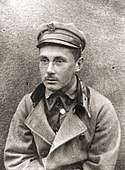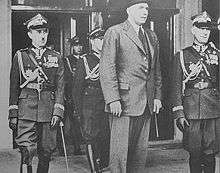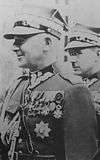Wacław Stachiewicz
| General Wacław Stachiewicz | |
|---|---|
|
| |
| Chief of the General Staff | |
|
In office 7 June 1935 – 18 September 1939 | |
| Preceded by | Janusz Gąsiorowski |
| Succeeded by | Aleksander Kędzior (in exile) |
| Personal details | |
| Born |
19 November 1894 Lwów |
| Died |
12 November 1973 (aged 78) Montreal |
| Profession | Geologist, writer |
| Awards |
|
| Military service | |
| Allegiance |
|
| Service/branch |
Polish Legions Polish Army |
| Years of service | 1912–1939 |
| Rank | Brigadier General |
| Battles/wars |
First World War Polish–Soviet War |
Wacław Teofil Stachiewicz (19 November 1894 – 12 November 1973) was a Polish writer, geologist, military commander and a general of the Polish Army. Brother to General Julian Stachiewicz and husband to Gen. Roman Abraham's sister, Stachiewicz was the Chief of General Staff of the Polish Army during the Polish Defensive War of 1939.
Early life and military career

Wacław Teofil Stachiewicz was born November 19, 1894 in Lwów (Lemberg, L'viv) in Austro-Hungarian Galicia. After graduating from one of local gymnasiums, he entered the geological faculty at the University of Lwów. In 1912 he joined the underground Związek Strzelecki, where he received military training and graduated from NCO and officer courses. After the outbreak of the Great War, in August 1914 he joined the Polish Legions, where he became a platoon commander in the 1st Regiment. On October 9 he was promoted to Second Lieutenant and sent with a secret mission to the other side of the Russo-Austrian front to help in creation of Polish underground organizations in the territory still under Russian occupation. In 1915 he was moved to the newly formed 5th Regiment, where he commanded the 4th company. Wounded in the battle of Konary, he was moved to various staff duties, among others he served as an aide to the chief of staff of the regiment. In March 1917 he graduated from an officer course of the General Staff and was to be promoted.
Oath Crisis and rebirth of the Polish Army
However, in the effect of the Oath Crisis of 1917 he was drafted into the Austro-Hungarian Army, demoted to sergeant and sent to the Italian Front. In March of the following year he defected from the army, returned to Poland and joined the secret Polish Military Organization. He headed that organization's central branch based in Warsaw. After Poland regained her independence, Stachiewicz's organization became one of the cores of the reborn Polish Army. Initially serving as the head of the I Detachment of the General Staff and the deputy chief of staff of the Warsaw military district, Stachiewicz soon became a staff officer of General Stanisław Haller's Army. He also served in a number of roles in the Polish Ministry of War Affairs. During the battle of Warsaw of 1920 he served as a deputy chief of staff and chief of operations of Gen. Kazimierz Sosnkowski's Volunteer Army. After the end of hostilities and the Peace of Riga, Stachiewicz returned to the ministry.

In 1921 he was sent to Paris, where he graduated from Ecole Supérieure de Guerre in late 1923. Upon his return he became a professor of tactics at the Wyższa Szkoła Wojenna in Warsaw. In April 1926 he started a year of practice at the post of head of 1st detachment of the Polish General Staff and in June of the following year he became the 1st Officer of the Staff of the General Inspectorate of Armed Forces. In January 1928 he completed his practice as the commanding officer of the Częstochowa-based 27th Infantry Regiment. Finally, after a year of training there he became the chief of infantry in the elite 1st Legions Infantry Division in Wilno. In December 1933 he returned to Częstochowa, this time as a commanding officer of the entire 7th Infantry Division and in 1935 he was promoted to the rank of Brigadier General. After the death of Marshal of Poland Józef Piłsudski, his place was taken by General Edward Rydz-Śmigły who nominated Stachiewicz for the post of the Chief of Staff of the Polish Army.
World War II, exile and death

One of the most promising staff officers in the Polish military, Stachiewicz was the author of various military plans, among them the Plan Zachód, the Polish plan of operations in case of a war with Nazi Germany and the Plan Wschód, a similar plan in case of a war against the Soviet Union. He was also the officer to prepare the Polish mobilization. In late 1939 he supervised the mobilization which was successfully accomplished despite the fact that it had to be called off due to British and French pressure. After the outbreak of the Polish Defensive War he automatically became the Chief of Staff of the headquarters of the Polish commander-in-chief. However, due to lack of communication he lost any influence on the conflict and withdrew together with Rydz-Śmigły to south-eastern Poland. After the Soviets joined the war on the side of the Nazis, on September 18 he crossed the border with Romania in order to continue the struggle abroad in France. However, due to internal struggle for power among the Polish emigrees, the French pressured the Romanian authorities and both Stachiewicz and his superior were interned.
In January 1940 Wacław Stachiewicz managed to escape from captivity and, through Bucharest and Yugoslavia, reached the French-held port of Algiers. However, due to Gen. Władysław Sikorski's insistence he was again interned, this time by the French, and it was not until 1943 that he finally reached London. There he spent the remaining part of the war, without any assignment. After World War II he was deprived of his Polish citizenship by the Soviet-backed communist authorities of Poland and had to remain in exile.
In 1948 he moved to Montreal in Canada. Blamed by many for the Polish defeat in the war, Stachiewicz devoted himself to writing and was an author of several books on the Polish preparations for the war of 1939. He died November 12, 1973. The Polish Library of the McGill University is named after him.
Honours and awards
- Silver Cross of the Virtuti Militari
- Commanders of the Polonia Restituta, previously awarded the Officer's Cross
- Cross of Independence with Swords
- Cross of Valour - four times
- Gold Cross of Merit
- Knight's Cross of the Legion of Honour
- Order of the Cross of the Eagle, Class I (Estonia, 1937)
See also
| Wikimedia Commons has media related to Wacław Stachiewicz. |
Bibliography
- Stanley S.Seidner (1978). Marshal Edward Śmigły-Rydz Rydz and the Defense of Poland. New York, PIAS.
- Wacław Stachiewicz (1998). Wierności dochować żołnierskiej (Remain faithful to the soldiers). Warsaw, RYTM. p. 832. ISBN 83-86678-71-2.
- Wacław Stachiewicz (1977). Pisma (Works) (Tom 1: Przygotowania wojenne w Polsce 1935-1939 (Part 1: War Preparations in Poland) ed.). Paris, Instytut Literacki. p. 239.
- Wacław Stachiewicz (1979). Pisma (Works) (Tom 2: Rok 1939 (Part 2: 1939) ed.). Paris, Instytut Literacki.